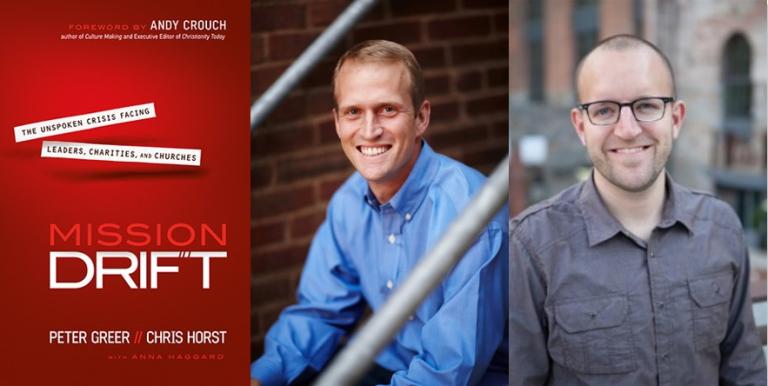Mission drift is inevitable. Your church, your non-profit, your business, your family — even you as an individual can’t avoid it.
Drift happens.
Such is the conclusion reached by Peter Greer and Chris Horst of HOPE International in their new book Mission Drift: The Unspoken Crisis Facing Leaders, Charities, and Churches, published by Bethany House Publishers.
But rather than simply diagnose the illness as inevitable and declare your organization’s case to be terminal, the two veteran non-profit leaders offer tangible solutions, specific action steps to cure mission drift and keep you and your organization “Mission True” for generations to come.
They propose a strategy that any organization, but especially a faith-based organization that embraces a gospel-centric mission, can employ to ensure it remains true to its original mission. Packed with moving stories and documented with compelling research, Mission Drift offers concrete steps and tools to equip leaders who want to combat pull away from their core purpose. Chapters on selecting board members, measuring what matters, and the critical but often neglected topic of organizational culture typify the invaluable content offered by Peter and Chris.
Mission Drift is a must-read for any leader — at any level — in a faith-based organization. It even offers an online assessment toolto help you gauge how vulnerable your organization may be to this pernicious and ubiquitous foe.
Interview with Peter and Chris
The two leaders graciously agreed to answer some follow-up questions regarding Mission Drift, questions I thought might be of particular interest to this FaithWalker’s community and readers at Patheos:
Me: My working definition of faith is “doing what you believe to be true, often in spite of what you see, sense or feel.” Would it be too much of a stretch to say that mission drift is a measure of the faith of an organization’s leadership, of its level of commitment to what it claims to believe?
P & C: In writing this book, we changed our hypothesis.
Initially, we saw Mission Drift as an organizational issue. But as organizations are made up of individuals foiled by pride and sin and allured by success, we concluded that this unspoken crisis isn’t an organizational problem. It’s a human one.
God has called us to lives of faithfulness. And faithfulness is the lifeblood of Mission True organizations.
Me: You devote a chapter to what one might think is the obvious, critical need of hiring the right people who share the mission of the organization. “Hire slow, fire fast” is what you say Mission True organizations do. What would you say to the tired non-profit executive who hears every day from stakeholders about the position that has not yet been filled?
P & C: Leaders need to be reminded that no matter how much pain you experience with the position unfilled, it is nothing compared to filling it with the wrong person and though it may feel unending, the wait is relatively short term.
Consider Phil Vischer, founder of Veggie Tales. At a company meeting trying to set strategy and mission, he stood up to share his founding vision.
“I am a Christian,” I said, “and I believe the Bible exclusively holds the truth about our standing before God and the path to restore our relationships with him. I want to share that truth with our culture. That is, at the end of the day, what Big Idea is about.”
Vischer didn’t receive the response he expected. His president of two years said, “If that’s what this is about, I need to opt out.”
In his personal account of Big Idea’s demise, Vischer writes: The room went deathly silent. I felt like a complete idiot. The man I had hired to help me accomplish my mission lacked my motivation entirely. I was mortified to realize that my failure to get to know him before—or after—offering him the most important job in the company had greatly contributed to the organizational mess my ministry had become.[1]
Me: The book understandably focuses on non-profits and humanitarian organizations, but isn’t the message of Mission Drift just as relevant to businesses, nations, and even families? Would your suggestions apply equally in such settings?
P & C: We wrote the book specifically for faith-based Christian leaders; however, many of the principles of drift apply to business, and we know of several business leaders going through Mission Drift with their executive teams.
But we were surprised when readers started applying Mission Drift to their personal lives and marriages.
One hypothesis in Mission Drift is that small decisions matter. In physics, a theory for drift exists. The second law of thermodynamics states that in the natural order of the universe, things degenerate, rather than come together. For example, when a frying pan is taken off the stove, the energy of heat will diffuse in the air, leaving the pan cooler. Unless more energy is added—someone puts the frying pan back on the stove—it will lose its heat and return to room temperature.[2]
What we see in science we found to be the norm within organizations, businesses—and in people’s personal lives. If you are not intentional about small decisions in your personal goals, marriage, and business, you will experience drift.
Me: To follow up on the previous question, do you think that non-profits are more susceptible to the pressures of Mission Drift because of their tax-exempt status and dependence on donor support?
P & C: Mission Drift can happen to anyone. And, yes, dependence on donor money can make one vulnerable to Mission Drift as donors exert a powerful influence on mission.
But nonprofits are also particularly prone to drift is because a vast number of charities are created with a clear faith foundation, mission and motivation. Often individuals starting such organizations were motivated by Christ’s love to address needs in tangible ways.
But in an increasingly secular world, those with an overt religious mission are more prone to Mission Drift: You can justify humanitarian actions more easily to the public than the Christian belief underpinning the action.
Me: You say in the book: “Funding is influence.” Christian non-profit leaders, especially pastors, seem to struggle most to turn away funding when they begin thinking of the organizational mission as their own personal mission rather than as part of God’s greater mission. What steps would you suggest to safeguard against this pattern?
P & C: First, we need to reframe success. As long as the size of your budget or number of those served are the exclusive yardstick of success, then you will do anything to grow.
Growth and increased funding are good things, but they might actually lead to drift if not coupled with other impact indicators.
Me: You say that Christian leaders are often quiet about the crisis of Mission Drift in our boardrooms, hiring practices, and fundraising strategies – even when they suspect it is taking place. I agree and ask this question: why the silence? What are the key factors that cause them to keep quiet?
P & C: We’re talking about difficult issues—matters of core purpose and faith. Such conversations aren’t easy. In fact, for many leaders and boards, it’s uncomfortable to discuss.
We like to avoid pain and often opt for the path of least resistance. It’s far easier to talk about professional experience and academic credentials than about core motivation and faith. Instead of focusing our energy on the organization’s most important asset—its Christ-centered purpose and calling—we are drawn to issues where we can more easily measure our success and outcomes.
Me: Based on your research, what percentage of evangelical Christian non-profits do you think are Mission True organizations? Do you see those numbers increasing or decreasing?
P & C: In a survey of hundreds of Christian leaders at the Q conference in Los Angeles in 2013, 95 percent said Mission Drift was a challenging issue to faith-based nonprofit organizations.[3]
It’s no secret issues of drift are increasing as our culture moves away from its historic Christian roots. Organizations without a clear vision will quickly collapse in the process.
To better assess the prevalence of drift and what keeps organizations Mission True, Chris and I have created the Mission Drift Survey (here), which faith-based organizations can take to better understand their susceptibility to drift.
Notes:
Click to pick up a copy of Mission Drift: The Unspoken Crisis Facing Leaders, Charities, and Churches. Explore my previous interview with Peter Greer on The Spiritual Danger of Doing Good
with a click here.
If you’ve experienced Mission Drift or watched it take place, leave a comment below with your thoughts and/or story.
Have you subscribed to our FaithWalkers email updates? Click here to receive posts delivered direct to your inbox.













